From radio with love: A Cold War astronomical collaboration
DOI: 10.1063/pt.jqfv.vqsp
In 1969, with East–West tensions high, scientists from the US and the USSR carried out an unprecedented cross-border experiment in radio astronomy. Designed to push the limits of a new technique called very long baseline interferometry (VLBI), it required trust and cooperation between both sides. Overcoming a host of political, cultural, and logistical hurdles, US and Soviet astronomers connected two radio telescopes—one in Green Bank, West Virginia, and one in the Ukrainian peninsula of Crimea—to create a single virtual telescope with a baseline as large as the distance between them. The result was not only a historic leap in observational capabilities but also a surprising collaboration between rivals.

The 140-foot telescope at Green Bank Observatory, pictured in 1965. (Photo by J. Baars, courtesy of NRAO/AUI/NSF/CC BY 4.0
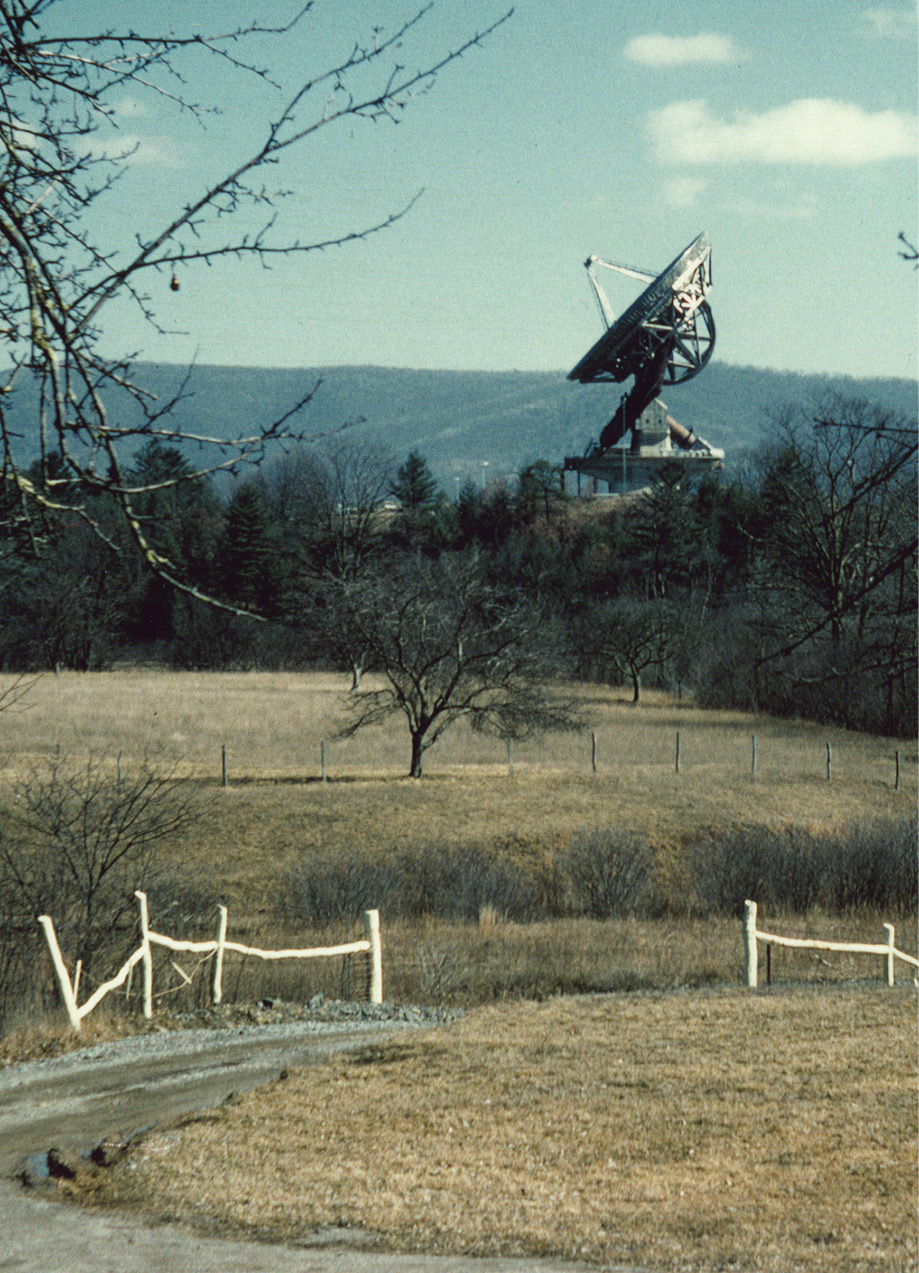
Invented in the mid 1960s, VLBI is at the heart of cutting-edge astronomical observations even today. The black-hole images published by the Event Horizon Telescope since 2019, for example, were made possible by the technique (see “A portrait of the black hole at the heart of the Milky Way
In fact, the widely separated radio antennas need not even be physically connected to achieve unprecedented angular resolution. With radio telescopes scattered across the globe, VLBI has imaged the radio emission from astronomical objects that would otherwise be impossible to resolve, such as distant quasars, neutron stars, and supermassive black holes. But because the technique relies on precise synchronization and data sharing across political borders, it often involves as much diplomacy as astrophysics.
A new spectrum
Radio astronomy emerged in the 1930s, when Karl Jansky, working at Bell Labs, accidentally discovered radio waves emanating from the center of the Milky Way while he was investigating static interference in transatlantic telephone signals. That unexpected discovery enabled a new way of observing the universe—one that would eventually reveal objects and phenomena that were previously unrecognized, such as pulsars, quasars, and the cosmic microwave background.
At the heart of a radio telescope’s sensitivity is its collecting area. Large parabolic dishes gather radio waves and focus them into a feed horn, a funnel-shaped component that directs the signal to a receiver that amplifies the faint waves and converts them into electrical signals for analysis. But because radio wavelengths, which range from millimeters to meters, are so much longer than those of visible light, achieving fine angular resolution requires radio telescopes to be far larger than their optical counterparts.
Until the mid 1960s, radio astronomers were able to improve their observational capabilities by building ever-larger radio dishes. The Arecibo telescope in Puerto Rico, completed in 1963, for example, had a whopping 305-meter diameter. But as the decade wore on, the community began facing a technological limitation. Not only were large telescopes expensive and difficult to build, but at a certain point, the effects of gravity made it impossible for a telescope to support itself and maintain its parabolic shape. Observing distant, faint objects in the radio spectrum would require telescopes with far better resolution than a single dish could provide.
Enter interferometry and aperture synthesis. Building on techniques they had learned developing radar during World War II, Martin Ryle and others realized that by combining signals from multiple telescopes spread out across a distance, they could simulate a much larger telescope and get significantly higher resolving capabilities. The technique became a staple in radio astronomy and earned Ryle a share of the 1974 Nobel Prize in Physics.

A schematic diagram illustrating the principles of very long baseline interferometry. A wave approaches Earth and is measured by two radio telescopes at different locations. To combine the measurements, astronomers need to know the precise time at which each observation was taken. (Image from J. Broderick, “VLB Interferometry,” The Observer, January 1970, p. 7.)
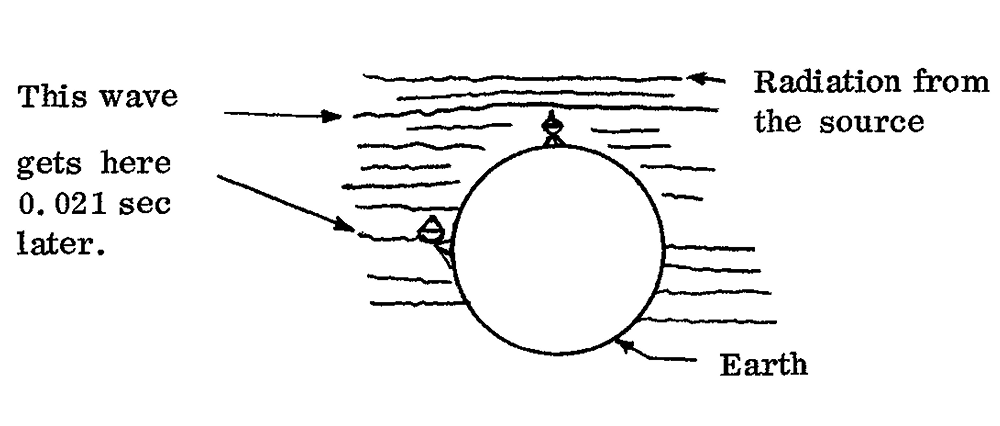
But combining signals from distant telescopes isn’t straightforward. As illustrated in the diagram above, radio waves hit each telescope at a slightly different time, depending on how far apart the telescopes are. Astronomers needed to precisely align those signals to measure that time difference. As early as the 1940s and 1950s, researchers were able to achieve that task for telescopes positioned close enough that they could be connected by coaxial cable. But doing so would be far more complicated for telescopes that were many hundreds or thousands of kilometers apart—perhaps even located on different continents—and thus too distant to be physically networked. The payoff promised to be immense. By increasing the distance between telescopes, called the baseline, astronomers could dramatically improve angular resolution: An interferometer comprising two telescopes 1000 kilometers apart can achieve a resolution approximately 10 000 times as fine as that of a single 100-meter dish.
Simultaneous invention
The story of VLBI does not hinge on a single breakthrough but rather a convergence of technological advances and scientific ambitions during the Cold War. In the US, radio astronomers sought sharper resolution to study distant quasars and map Earth’s rotation with greater precision. In the USSR, astronomers had limited access to large single-dish antennas and pursued interferometry to enhance observational power using existing infrastructure. Researchers in both countries were aided by several crucial new technologies, including highly stable atomic clocks and high-speed tape recorders. Those innovations, which arose nearly simultaneously in several countries, spurred several groups to independently begin experimenting with using disconnected telescopes for long baseline interferometry.
The idea of a collaborative East–West VLBI experiment emerged early on, in 1963, when UK astronomer Bernard Lovell discussed the idea with Soviet astrophysicist Iosif Shklovsky and others during a trip to the USSR. The two signed an agreement to test the concept, but the proposed experiment never got off the ground. Two years later, Soviet scientists Leonid Matveenko, Nikolai Kardashev, and Gennady Sholomitskii published an article proposing the use of atomic clocks to synchronize signals from widely separated telescopes that could not be physically connected. 1 Calling the technique radiointerferometr s bolshoy bazoy (“radio interferometry with large baselines”), they envisioned that the telescopes could be positioned virtually anywhere—even on different continents—and that extraordinary resolutions could be achieved. But because it appeared in a Russian-language journal with limited distribution in the West, and the journal’s English translation was just getting off the ground, the paper went largely unnoticed by the astronomical community.
The first VLBI experiment arguably took place in January 1967, when scientists at the University of Florida in Gainesville and Florida Presbyterian College in St. Petersburg combined tape-recorded signals from two disconnected antennas to observe Jupiter’s radio bursts. The team was able to synchronize the data by placing at each telescope a crystal oscillator, which time-stamped and stabilized the frequency of the incoming signals. Although the baseline of 218 kilometers wasn’t especially long, the innovative experiment ushered in the core technique of VLBI: synchronizing and correlating data from separated instruments. But the paper announcing the results didn’t appear until 1968, 2 so the work had little immediate impact. Around the same time, a team of Canadian researchers used a similar technique to perform an experiment with telescopes separated by just 200 meters. That group published its findings in June 1967. 3

The 22-meter radio telescope at the Simeiz Observatory in Crimea used in the 1969 US–USSR VLBI experiment. (Photo by K. Kellermann, courtesy of NRAO/AUI/NSF/CC BY 4.0
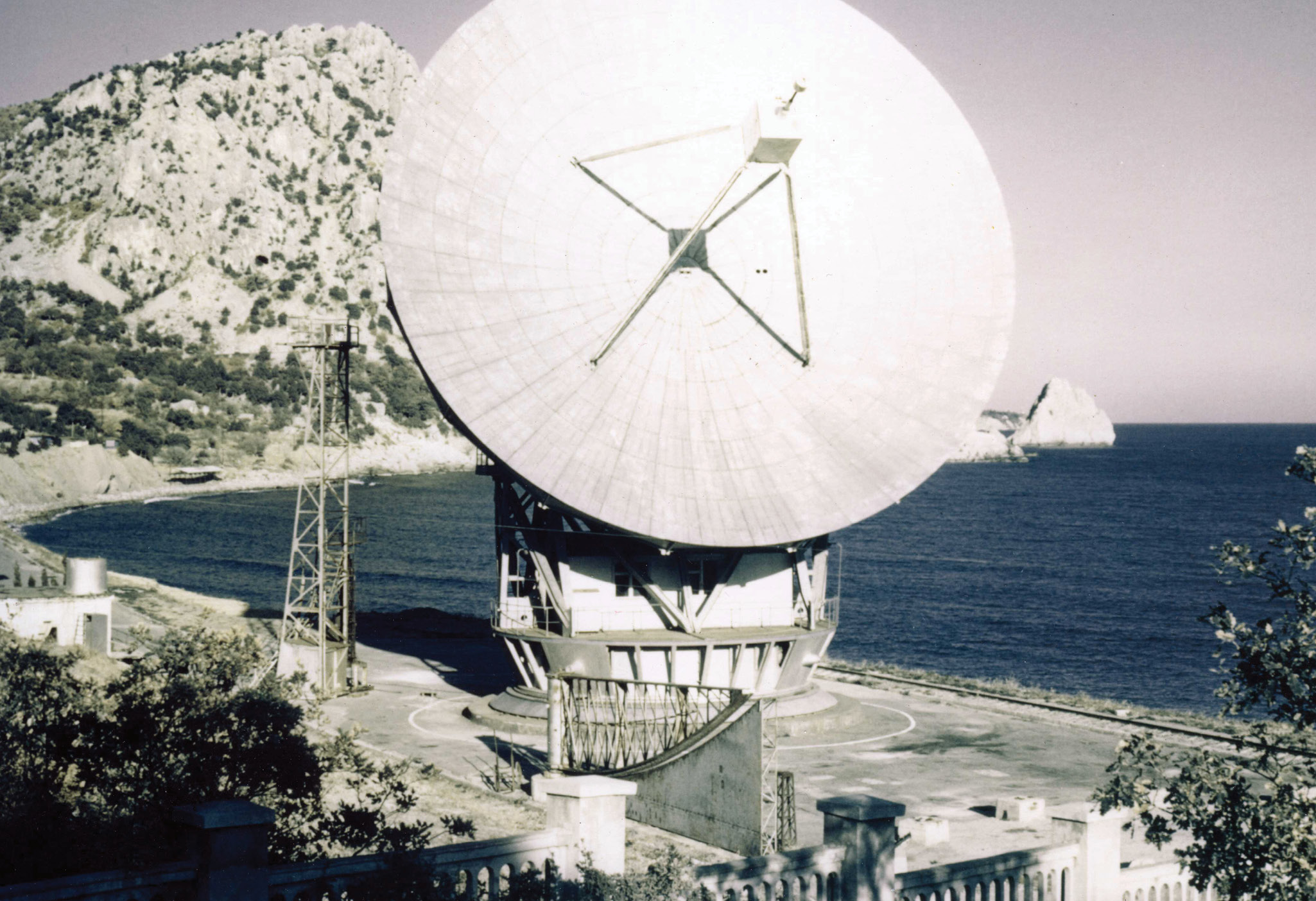
One month later, teams working at the National Radio Astronomy Observatory (NRAO) and the Naval Research Laboratory (NRL) published the results of a collaborative VLBI experiment that they had conducted that May. 4 Their independently operated telescopes, located in Green Bank and the Maryland Point Observatory, were separated by 220 kilometers—approximately the same baseline as the Florida experiment—but because their observations were made at a frequency more than 100 times as high as the Florida group’s were, the images produced had much better resolution. The idea for the experiment famously came about over a lunchtime pitcher of beer: A fittingly collaborative and spontaneous origin for a project that would go on to revolutionize astronomy.
So who deserves credit for inventing VLBI? The answer is less about a single inventor and more about parallel innovation and simultaneous invention: Several groups from different countries arrived at the same idea around the same time. The result was not just a new technique but a new kind of radio astronomy—one that reflected the collaborative, globally distributed nature of the field itself.
Planning the experiment
To build on the experiment done with the NRL telescope, the NRAO scientists sought to collaborate with researchers from observatories around the world. Their first international collaboration was in January 1968 with a Swedish team, during which the two teams successfully linked telescopes over 6000 kilometers apart. 5 Encouraged by that success, the NRAO researchers set their sights on achieving an even finer resolution, which required a combination of long baselines and telescopes that could observe at low frequencies with sufficient sensitivity. They first hoped to work with Australian astronomers, but facilities such as the large radio telescope at Parkes Observatory in New South Wales weren’t yet fully equipped for the demands of VLBI.

US and Soviet astronomers celebrate with glasses of cognac after the first successful VLBI observations were made at the Simeiz Observatory in October 1969. Standing, from left, are observatory director Ivan Moiseyev, John Payne of the NRAO, and Victor Efanov, one of the observatory’s support staff. Seated in front is another, unnamed observatory employee. (Photo by K. Kellermann, courtesy of NRAO/AUI/NSF/CC BY 4.0
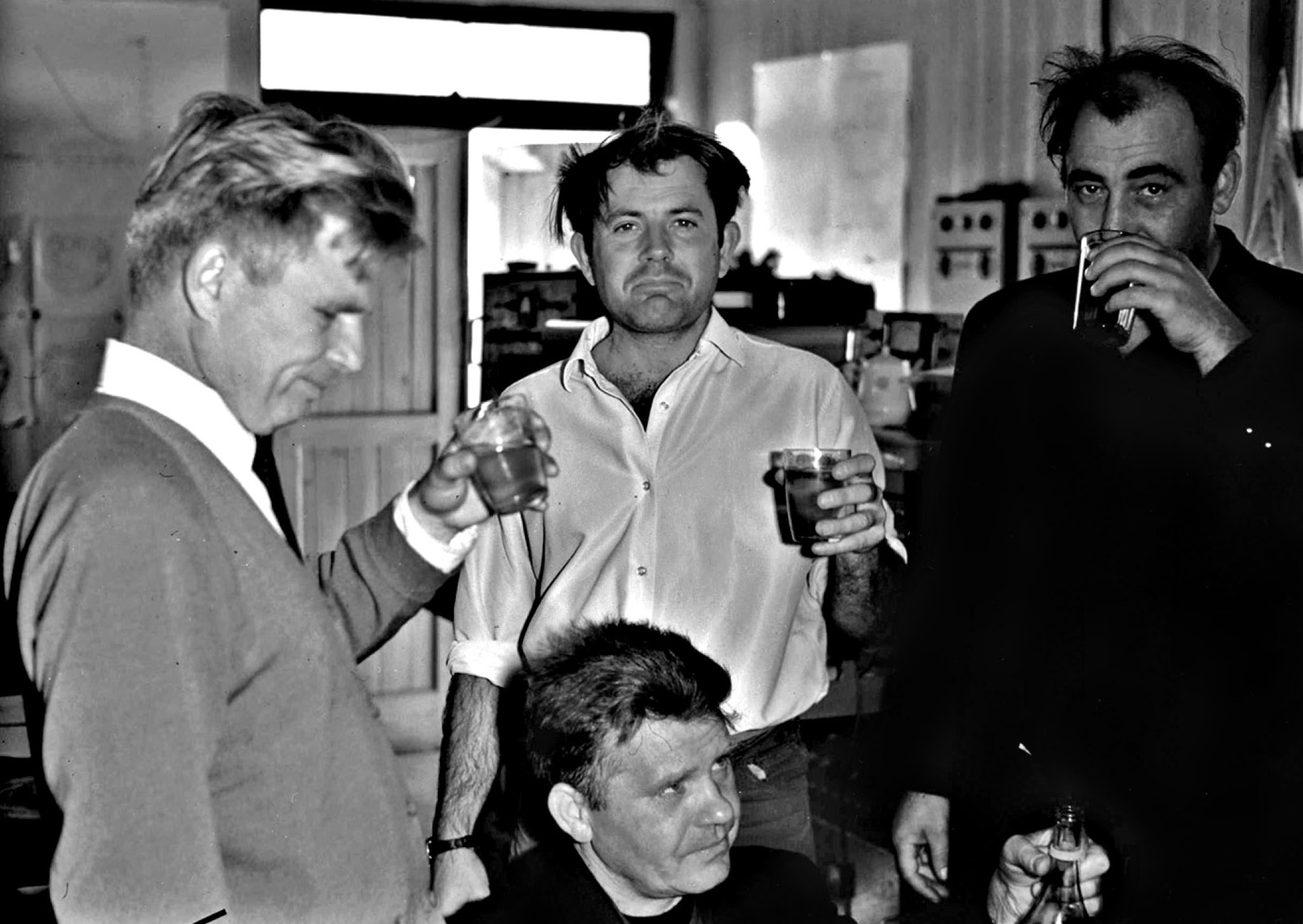
The team soon realized that some of the best options were in the USSR, which had invested heavily in radio astronomy and possessed several large dishes suitable for VLBI experiments. So in February 1968, NRAO radio astronomer Kenneth Kellermann and Marshall Cohen, then at the University of California, San Diego, sent a letter to Soviet scientist Viktor Vitkevich of the Lebedev Physical Institute in Moscow, in which they pitched a collaborative experiment that would use the NRAO’s 140-foot radio telescope in Green Bank and an antenna in the USSR.
The Soviets agreed to collaborate and suggested using the 22-meter radio telescope at the Simeiz Observatory in Crimea. So in late 1968, the NRAO team jumped into planning mode. The VLBI experiment would be one of the earliest high-profile examples of US–Soviet scientific collaborations made possible during détente, the period during the late 1960s and 1970s when Cold War tensions eased and the two superpowers promoted cooperation in science and technology. The thaw in relations opened channels for collaboration that had been closed for decades and enabled joint projects that would have been politically unthinkable just a few years earlier.
In an internal report outlining the scientific goals of the collaboration, Kellermann and his NRAO colleagues explained why it would be ideal to use the Crimean telescope: Not only was it well situated for achieving the long baselines necessary for high-resolution observations, but it was one of only a few non-US telescopes that could observe at the required wavelengths with the necessary sensitivity for the demanding experiment. 6
The report highlighted two major challenges that the collaboration would face, which would need to be smoothed out with careful preparation. The first was communication: To quickly resolve the inevitable technical issues the teams would face, researchers in the US and USSR needed to constantly be in touch. Language barriers compounded the challenge: Few US scientists spoke Russian, and vice versa. To complicate matters further, both US and Soviet scientists needed to visit each other’s facilities to familiarize themselves with the other team’s equipment and procedures, which meant that they came up against Cold War travel restrictions.
Even during détente, personnel exchanges between the US and the USSR remained rare and were subject to strict political oversight. On the Soviet side, often only scientists who were Communist Party members or in good political standing were permitted to travel. And both governments encouraged or required their scientists to report both on foreign visitors and on their own experiences during visits abroad. The atmosphere of surveillance and political caution complicated the smooth functioning of the collaboration.
The second hurdle was gaining permission to export technically sensitive instrumentation to the USSR. One of the most critical pieces of equipment for the experiment was an atomic clock, which helped precisely synchronize signals between the telescopes in Green Bank and Crimea, separated by more than 5000 kilometers. The NRAO team needed to bring the clock from the US to the Simeiz Observatory, which required clearance from the Office of Export Control in the Department of Commerce. But that wasn’t all: The Department of Defense had national security concerns about conducting VLBI because the technique was also used in geodesy—the scientific study of Earth’s shape, orientation, gravitational field, and movement.

An atomic clock similar to the one used in the 1969 US–USSR VLBI experiment. (Courtesy of NRAO/AUI/NSF/CC BY 4.0
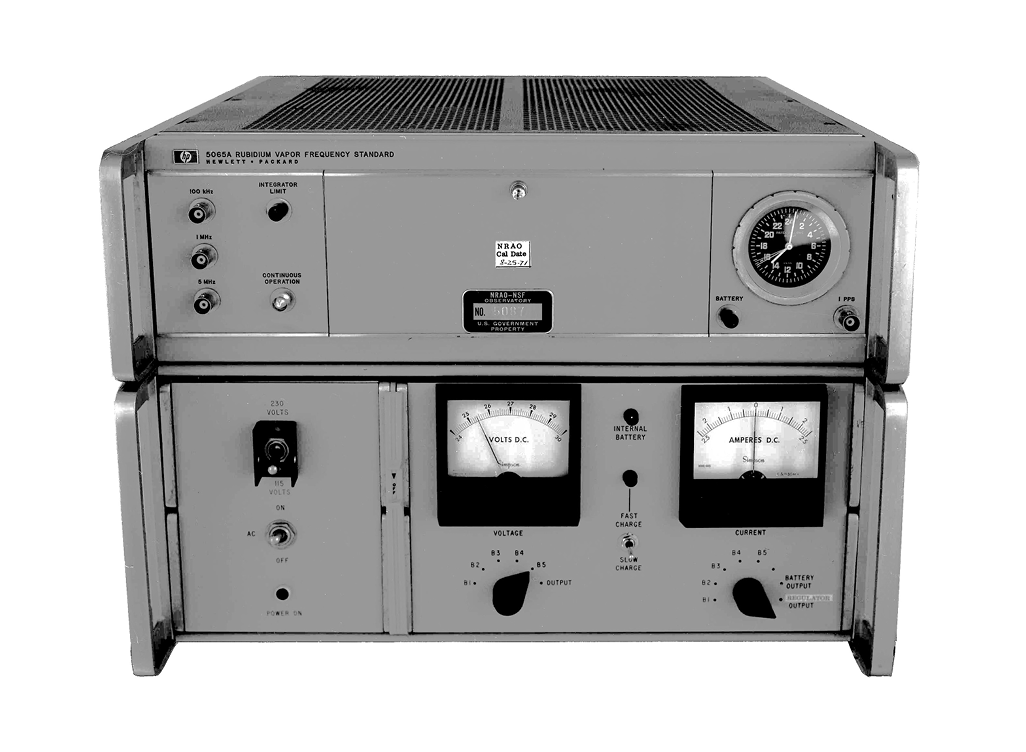
Geodetic information is also vital for guiding intercontinental ballistic missiles. At the time, VLBI could locate radio antennas’ positions to within a few meters, which alarmed the DOD. The department feared that if extremely precise geodetic data regarding the NRAO 140-foot telescope’s exact location were shared with the USSR, it might help the Soviets improve their ability to accurately aim missiles at high-value US targets in the general vicinity of Green Bank, including Washington, DC. At one point, representatives from the DOD visited the NRAO to voice their concerns. 7 But in the end, the DOD did not object to the experiment: Both the US and USSR were already launching spy satellites into Earth’s orbit that provided comparably precise geodetic measurements.
Overcoming difficulties
Even after receiving official permission to export the atomic clock, physically transporting it across the Atlantic Ocean and within the USSR proved to be an ordeal. Packed into a large, unmarked crate, the clock looked suspiciously like an oversized bomb to Soviet airport security. Out of concern that the term would evoke nuclear anxieties to Soviet customs officials, the US astronomers were careful not to call their device an “atomic” clock. But even without the word atomic, transporting the large device caused concern. As Kellermann later recalled in a retrospective essay for The Observer, the NRAO’s internal newsletter: “Imagine a Russian trying to get on a flight from Miami to New York carrying a strange looking box (ticking, of course) with wires and batteries, and having only a voltmeter, pair of plyers, and a large screwdriver for luggage, and you get the picture.” 8
After several delays and intense scrutiny, the team finally arrived in the USSR with the clock. But the challenges didn’t end there. At the Pulkovo Observatory near Leningrad, the team members synchronized the clock with a Swedish reference, but the internal battery started running low during their flight to Crimea. That posed a major problem because the atomic clock needed continuous power to preserve its precise time calibration. They hooked it up to a car battery they had brought as a backup and, after landing, loaded the ungainly contraption into a car to drive to the Simeiz Observatory. But that battery, too, began to falter midway through the trip. Improvising, they hooked up the clock to the car’s battery for power and ultimately managed to arrive at the observatory before that also died.
Although the team expected to face communication challenges, maintaining contact between Green Bank and Crimea proved even more difficult than expected because of a series of unforeseen issues. The team members originally planned on communicating via TWX machines—a precursor to fax technology—but that method failed. Telephone lines went down. As a last resort, they turned to telegrams, but even those faced near-comedic hurdles. As Kellermann recounted, “It took a while to explain [to a representative at the Soviet telegraph office] that Green Bank was not a major U.S. city and the telegram went off—or so we thought. Four days later the telegraph office called me at the hotel. They still wanted to know where Green Bank was.” The communication ordeal between the two nations was so great that the collaboration earned the unofficial nickname the “Russian–American International Clock Test.” 8
Cultural differences and language barriers posed further challenges. The US team needed to install sensitive electronic receivers on the 22-meter telescope that would capture and amplify the faint radio signals from distant quasars before recording them on magnetic tape. Although the local mechanics were capable, they seemed unconcerned about the urgency of the project. John Payne, a member of the US team, was “having considerable trouble getting them organized,” Kellermann later recalled. “They kept telling him that this was Russia, not America, and he should relax, have some Vodka, and not be in such a hurry.” 9 Despite the setbacks, the team was ready for its main observing run by October. After successfully making the first set of observations, the scientists celebrated with food, vodka, cognac, and declarations of Soviet–US friendship before heading back to the hotel.

A selection of the whimsical cartoons drawn to accompany Kenneth Kellermann’s three-part 1970 article in the NRAO’s newsletter, The Observer, that recounted the story of the 1969 VLBI experiment. (Cartoon of the radio dish and clock by Peggy Weems, and cartoons of the international clock test and the calendar with vodka by Shelton Reid, all courtesy of NRAO/AUI/NSF/CC BY 4.0
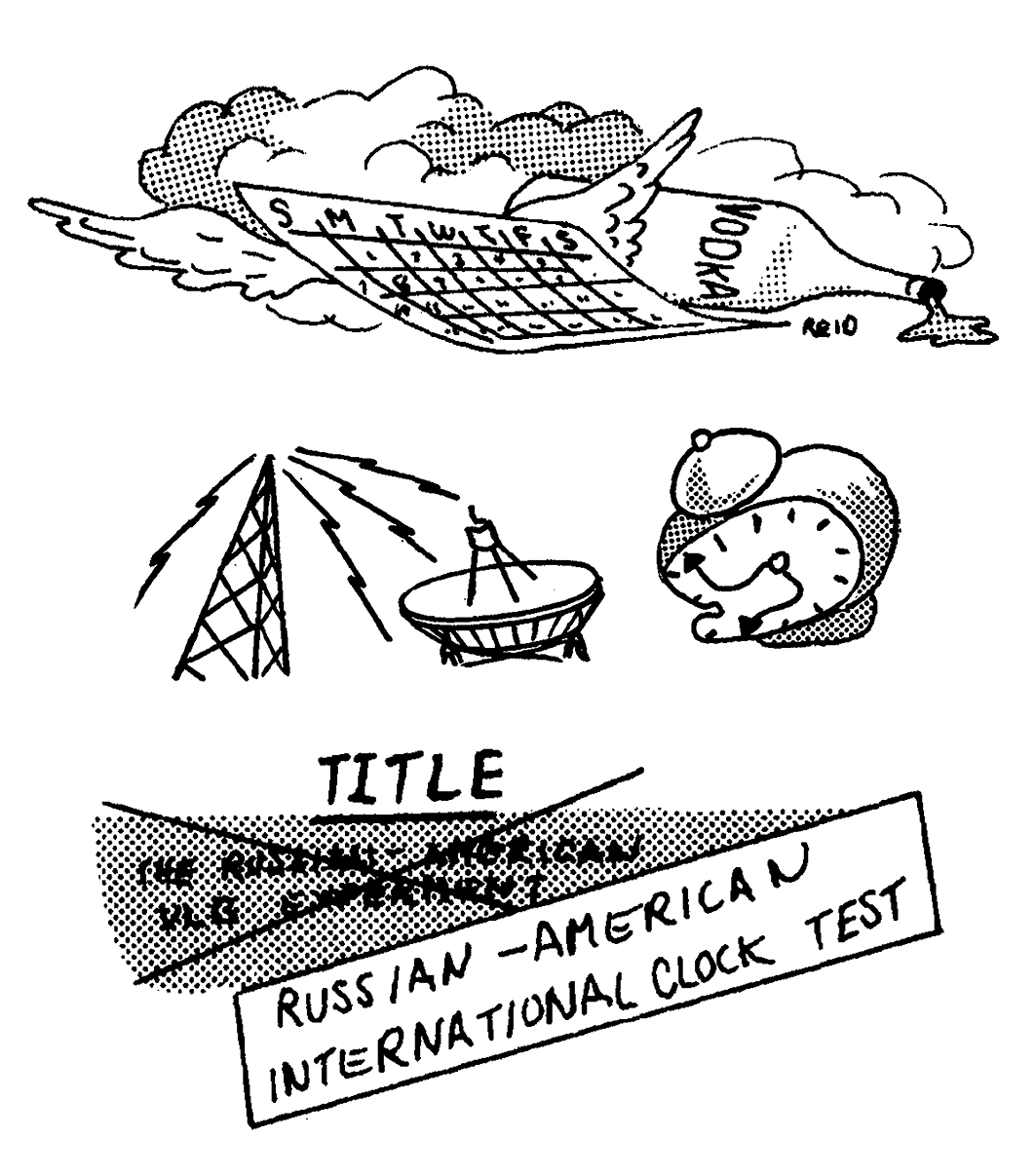
But then a telegram arrived from the NRAO with dire news: The frequency on the 140-foot telescope in Green Bank had been set incorrectly, and the run needed to be repeated from the start within the next two hours while the quasar the team was observing was still visible. Payne and Kellermann rushed back to the observatory only to find that the mechanical crew had decided to declare an impromptu holiday and were busy celebrating. Fortunately, the delay meant that the electronic receivers for that portion of the VLBI experiment hadn’t yet been removed from the telescope. With the help of Soviet radio astronomer Ivan Moiseyev, the director of the Simeiz Observatory, Payne and Kellermann were able to correct the error in time.
The joy of success
The team sent the tapes from the Crimean observations to Green Bank so the two sets of signals could be correlated. But they never arrived in West Virginia. In The Observer, Kellermann speculated that “somewhere either in Moscow, Washington, or both, teams of experts at the CIA or KGB were unsuccessfully trying to decode a magnetic tape containing a sequence of 150 million random numbers which had apparently been smuggled out of the USSR.” 10 Although the tapes were eventually located, the US astronomers’ suspicions that the Soviet intelligence agency was interested in their visit proved prescient: Kellermann revealed in a 2001 epilogue to his account that a trip to some tourist destinations in Central Asia “was arranged so that KGB engineers could have an uninterrupted week to reverse engineer our recorder, receivers and atomic clock.” 11
After a few more hiccups—at one point, in rapid succession, Green Bank’s hydrogen maser failed and a power transformer on the facility’s telescope exploded—the team was able to successfully complete the experiment in late October 1969. 12 Kellerman later described the joy of success after the myriad challenges the experiment had faced:
In a little over a month we had dispatched various shipments of people and equipment between Stockholm, Moscow, Lenningrad [sic], and Crimea by air, rail, and road. We had made unprecedented demands on transportation and communication facilities, and had apparently cornered the market on all the storage batteries in the Soviet Union….
… You can therefore imagine the general joy and relief when the telegram arrived announcing strong fringes on 3C 454.3. Vitkevich was at first speechless, but rapidly recovering he cried, “BRING THE VODKA!” Remembering that we still had two days of observing left the celebration was, however, postponed.
13
The target, 3C 454.3, an extremely luminous and distant quasar powered by a supermassive black hole, is cataloged in the Third Cambridge Catalogue of Radio Sources (hence the “3C”). It was selected because it appears as a strong, compact radio source, ideal characteristics for testing VLBI’s ability to achieve the best possible angular resolution. The scientists realized that they had been successful when they saw the telltale fringes—namely, the interference pattern created when the signals from both telescopes are combined and overlaid.
The experiment’s legacy
What are the lessons from this problem-riddled yet ultimately successful experiment? Scientifically, it demonstrated that VLBI could indeed be conducted across continents and at frequencies needed to obtain high resolutions. It also set the stage for tremendous leaps in observational capabilities in radio astronomy and paved the way for international VLBI networks that would later expand to include telescopes from around the world. But it was more than just a technical achievement: The experiment opened the door to collaborations between the US and the USSR—and, after 1991, Russia—that continued well into the 21st century. From 2011 to 2019, for example, Russian radio astronomers incorporated NRAO telescopes into the RadioAstron program, a VLBI experiment involving a satellite and several ground-based observatories that extended radio interferometry baselines to near-lunar distances and to an angular resolution of a few tens of microarcseconds. The Green Bank–Crimea observations, in contrast, had a resolution of 400 microarcseconds.
Today, however, collaboration between Russian and Western scientists has reached a nadir. Russia’s 2014 annexation of Crimea significantly strained international scientific collaborations that until then had been alive and well for almost five decades. Many of those efforts were completely fractured after Russia commenced a full-scale invasion of Ukraine in 2022, a conflict that remains ongoing (see Physics Today, June 2022, page 22
The scientists at the NRAO and the Simeiz Observatory were motivated to collaborate largely for practical reasons: Their experiment demanded cooperation across great distances. But it pushed the researchers to forge alliances even in the face of great logistical, cultural, and political divides. Their “science first” mentalities created a shared purpose that transcended those otherwise discouraging circumstances.
But they were not so single-mindedly focused on the experiment that its social and political implications escaped them. In his Observer essay, Kellermann explained that the experiment’s true success lay not only in the scientific results but also in proving that even during an era of profound geopolitical tension, collaboration could triumph over division: “Perhaps in some small way,” he wrote, “we have contributed to an increased understanding between Soviet and American people, and demonstrated that scientific cooperation between the U.S.A. and the U.S.S.R. is possible.” 14
That lesson feels especially urgent today. As global tensions rise and political winds shift—and with federal science funding threatened, international trust eroded, and collaborative global research initiatives increasingly at risk—the achievements of early VLBI pioneers remind us of what can be lost. Triumphs in VLBI such as the Event Horizon Telescope, which comprises a network of stations across the globe, show how far the collaborative spirit can take us. But those achievements were made possible not just by technology or funding but also by openness, risk-taking, and a belief in the value of knowledge shared across borders. In an age when the foundations of global science are being tested, we might look back to this Cold War collaboration as both a technical milestone and a model for the courage that will be required to meet the challenges ahead.
This article was originally published online on 19 August 2025.
This article is dedicated, with much gratitude, to Ken Kellermann, who has served as my mentor for nearly eight years. Ken remains a gift not only to radio astronomy but to its history. His firsthand accounts of this groundbreaking experiment—both preserved in the NRAO’s archives and personally shared with me during countless conversations—made this research possible. Ken’s continuing dedication to documenting the human stories behind scientific breakthroughs has ensured that future generations can learn not just what was discovered but also how discovery happens: through collaboration, persistence, and the occasional act of diplomatic courage.
References
1. L. I. Matveenko, N. S. Kardashev, G. B. Sholomitskii, Izv. VUZ Radiofiz 8, 651 (1965),
trans. as Sov. Radiophys. 8, 461 (1966). https://doi.org/10.1007/BF010383182. G. W. Brown, T. D. Carr, W. F. Block, Astrophys. Lett. 1, 89 (1968).
3. N. W. Broten et al., Science 156, 1592 (1967). https://doi.org/10.1126/science.156.3782.1592
4. C. Bare et al., Science 157, 189 (1967). https://doi.org/10.1126/science.157.3785.189
5. K. I. Kellermann et al., Astrophys. J. 153, L209 (1968). https://doi.org/10.1086/180253
6. “Long Baseline Interferometry Between the United States and the Soviet Union: Scientific Background and Potential Problem Areas,” report (n.d., ca. 1968–69), VLBI Series, Papers of Kenneth I. Kellermann, National Radio Astronomy Observatory/Associated Universities Inc Archives, Charlottesville, VA.
7. K. I. Kellermann, E. N. Bouton, S. S. Brandt, Open Skies: The National Radio Astronomy Observatory and Its Impact on US Radio Astronomy, Springer (2020), chap. 8.
8. K. Kellermann, “The Russian–American VLB experiment, part II,” The Observer, March 1970, p. 9.
9. Ref. 8, p. 8.
10. K. Kellermann, “The Russian–American VLB experiment, part III,” The Observer, July 1970, p. 7.
11. K. I. Kellermann, in But It Was Fun: The First Forty Years of Radio Astronomy at Green Bank, F. J. Lockman, F. D. Ghigo, D. S. Balser, eds., Green Bank Observatory (2016), p. 562.
12. J. J. Broderick et al., Sov. Astron. 14, 29 (1971).
13. Ref. 10, p. 12.
14. Ref. 10, p. 13.
More about the Authors
Rebecca Charbonneau is a historian at the American Institute of Physics in College Park, Maryland. Her research focuses on the history of radio astronomy.

